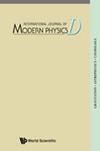时空作为非弹性介质的类比——我们能否从宇宙常数Λ建立空间的热膨胀系数
IF 2.1
4区 物理与天体物理
Q3 ASTRONOMY & ASTROPHYSICS
引用次数: 0
摘要
本文通过对时空结构与弹性结构的类比研究的延伸,推动了这一领域的发展。由于之前没有关于潜在时空热膨胀系数的研究[公式:见文],我们通过考虑宇宙学常数[公式:见文]作为由于来自宇宙网和冷真空的热梯度而产生的空间结构的额外空间曲率来探索广义相对论与弹性理论的类比,我们提出[公式:见文]以[公式:见文]作为空间结构的曲率半径。从这个类比和假定的由普朗克厚度薄片组成的空间模型[公式:见文]由这个热梯度[公式:见文]弯曲的空间模型[公式:见文]T可以得到一个量级为[公式:见文][公式:见文]K[公式:见文]的等效弹性介质的热膨胀系数。由于广义相对论必须考虑时空而不仅仅是空间,因此本文还提出了一种创新的方法,即在狭义相对论的区间ds2中引入基于空间和时间的不同热膨胀系数与时间流动的温度效应[公式:见文](熵变化与时间圈相关,基于温度变化总是影响物理时钟)[公式:见文]。对于[公式:见文]10 6[公式:见文]K,[公式:见文],关联时间间隔为[公式:见文][公式:见文]和[公式:见文]。这个假设的结果是,暗能量可能会变成热时空曲率[公式:见文],[公式:见文]等于[公式:见文]或[公式:见文],这取决于温度,宇宙的热熵变化,普朗克厚度和时间,从大爆炸开始增加,取决于时空的热膨胀系数[公式:见文]和[公式:见文]分别作为[公式:]的函数。[公式:见原文],与广义相对论中描述的由质量/能量密度引起的时空曲率引力相反。本文章由计算机程序翻译,如有差异,请以英文原文为准。
Analogy of space time as un elastic medium - Can we establish a thermal expansion coefficient of space from the cosmological constant Λ ?-
This paper advances the state-of-the-art by extending the study of the analogy between the fabric of spacetime and elasticity. As no prior work exists about a potential spacetime thermal expansion coefficient [Formula: see text], we explore the analogy of general relativity with the theory of elasticity by considering the cosmological constant [Formula: see text] as an additional space curvature of the structure of space due to a thermal gradient coming from the cosmic web and the cold vacuum and we propose [Formula: see text] with [Formula: see text] being the curvature radius of the space fabric. It follows from this analogy and from the supposed space model consisting of thin sheets of Planck thickness [Formula: see text] curved by this thermal gradient [Formula: see text]T a possible thermal expansion coefficient of the equivalent elastic medium modeling the space [Formula: see text] of the order of [Formula: see text][Formula: see text]K[Formula: see text]. As spacetime and not only space must be considered in general relativity, this paper also proposes an innovative approach which consists in introducing into the interval ds 2 of special relativity a temperature effect [Formula: see text] (entropy variations correlated with time laps, based on temperature variations affecting always physically the clocks) based on different thermal expansion coefficients for space and time with for the flow of time [Formula: see text]. With [Formula: see text] 10 6 [Formula: see text]K, [Formula: see text], the associate time interval is [Formula: see text][Formula: see text]s and [Formula: see text]. The consequence of this hypothesis is that dark energy potentially becomes a thermal spacetime curvature [Formula: see text] with [Formula: see text] equal to [Formula: see text] or [Formula: see text] depending of the temperature, the thermal entropy variation of the universe, the Planck thickness and time, that increases since the Big bang, depending on thermal expansion coefficients for spacetime [Formula: see text] and [Formula: see text] as a function, respectively, of [Formula: see text], [Formula: see text], in opposition to spacetime curvature gravity due to mass/energy density as described in general relativity.
求助全文
通过发布文献求助,成功后即可免费获取论文全文。
去求助
来源期刊

International Journal of Modern Physics D
地学天文-天文与天体物理
CiteScore
3.80
自引率
9.10%
发文量
181
审稿时长
4-8 weeks
期刊介绍:
Gravitation, astrophysics and cosmology are exciting and rapidly advancing fields of research. This journal aims to accommodate and promote this expansion of information and ideas and it features research papers and reviews on theoretical, observational and experimental findings in these fields. Among the topics covered are general relativity, quantum gravity, gravitational experiments, quantum cosmology, observational cosmology, particle cosmology, large scale structure, high energy astrophysics, compact objects, cosmic particles and radiation.
 求助内容:
求助内容: 应助结果提醒方式:
应助结果提醒方式:


